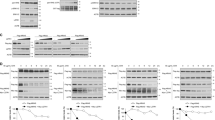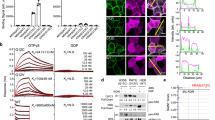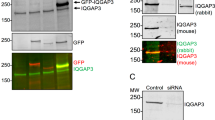Abstract
Cell growth and differentiation are controlled by growth factor receptors coupled to the GTPase Ras. Oncogenic mutations disrupt GTPase activity, leading to persistent Ras signaling and cancer progression. Recent evidence indicates that monoubiquitination of Ras leads to Ras activation. Mutation of the primary site of monoubiquitination impairs the ability of activated K-Ras (one of the three mammalian isoforms of Ras) to promote tumor growth. To determine the mechanism of human Ras activation, we chemically ubiquitinated the protein and analyzed its function by NMR, computational modeling and biochemical activity measurements. We established that monoubiquitination has little effect on the binding of Ras to guanine nucleotide, GTP hydrolysis or exchange-factor activation but severely abrogates the response to GTPase-activating proteins in a site-specific manner. These findings reveal a new mechanism by which Ras can trigger persistent signaling in the absence of receptor activation or an oncogenic mutation.
This is a preview of subscription content, access via your institution
Access options
Subscribe to this journal
Receive 12 print issues and online access
$189.00 per year
only $15.75 per issue
Buy this article
- Purchase on Springer Link
- Instant access to full article PDF
Prices may be subject to local taxes which are calculated during checkout







Similar content being viewed by others
References
Cox, A.D. & Der, C.J. The dark side of Ras: regulation of apoptosis. Oncogene 22, 8999–9006 (2003).
Kjeldgaard, M., Nyborg, J. & Clark, B.F. The GTP binding motif: variations on a theme. FASEB J. 10, 1347–1368 (1996).
Herrmann, C. Ras-effector interactions: after one decade. Curr. Opin. Struct. Biol. 13, 122–129 (2003).
Scheffzek, K. et al. The Ras-RasGAP complex: structural basis for GTPase activation and its loss in oncogenic Ras mutants. Science 277, 333–339 (1997).
Sprang, S. GEFs: master regulators of G-protein activation. Trends Biochem. Sci. 26, 266–267 (2001).
Sprang, S.R. G proteins, effectors and GAPs: structure and mechanism. Curr. Opin. Struct. Biol. 7, 849–856 (1997).
Bos, J.L. Ras oncogenes in human cancer: a review. Cancer Res. 49, 4682–4689 (1989).
Adjei, A.A. Blocking oncogenic Ras signaling for cancer therapy. J. Natl. Cancer Inst. 93, 1062–1074 (2001).
Karnoub, A.E. & Weinberg, R.A. Ras oncogenes: split personalities. Nat. Rev. Mol. Cell Biol. 9, 517–531 (2008).
Hicke, L. Protein regulation by monoubiquitin. Nat. Rev. Mol. Cell Biol. 2, 195–201 (2001).
Jura, N., Scotto-Lavino, E., Sobczyk, A. & Bar-Sagi, D. Differential modification of Ras proteins by ubiquitination. Mol. Cell 21, 679–687 (2006).
Kawabe, H. et al. Regulation of Rap2A by the ubiquitin ligase Nedd4-1 controls neurite development. Neuron 65, 358–372 (2010).
Nethe, M. & Hordijk, P.L. The role of ubiquitylation and degradation in RhoGTPase signalling. J. Cell Sci. 123, 4011–4018 (2010).
Visvikis, O. et al. Activated Rac1, but not the tumorigenic variant Rac1b, is ubiquitinated on Lys 147 through a JNK-regulated process. FEBS J. 275, 386–396 (2008).
Sasaki, A.T. et al. Ubiquitination of K-Ras enhances activation and facilitates binding to select downstream effectors. Sci. Signal. 4, ra13 (2011).
Merkley, N., Barber, K.R. & Shaw, G.S. Ubiquitin manipulation by an E2 conjugating enzyme using a novel covalent intermediate. J. Biol. Chem. 280, 31732–31738 (2005).
Chen, J., Ai, Y., Wang, J., Haracska, L. & Zhuang, Z. Chemically ubiquitylated PCNA as a probe for eukaryotic translesion DNA synthesis. Nat. Chem. Biol. 6, 270–272 (2010).
Virdee, S. et al. Traceless and site-specific ubiquitination of recombinant proteins. J. Am. Chem. Soc. 133, 10708–10711 (2011).
Kumar, K.S., Spasser, L., Ohayon, S., Erlich, L.A. & Brik, A. Expeditious chemical synthesis of ubiquitinated peptides employing orthogonal protection and native chemical ligation. Bioconjug. Chem. 22, 137–143 (2011).
Eger, S. et al. Generation of a mono-ubiquitinated PCNA mimic by click chemistry. ChemBioChem 12, 2807–2812 (2011).
Purbeck, C., Eletr, Z.M. & Kuhlman, B. Kinetics of the transfer of ubiquitin from UbcH7 to E6AP. Biochemistry 49, 1361–1363 (2010).
Mott, H.R., Carpenter, J.W. & Campbell, S.L. Structural and functional analysis of a mutant Ras protein that is insensitive to nitric oxide activation. Biochemistry 36, 3640–3644 (1997).
Reuther, G.W. & Der, C.J. The Ras branch of small GTPases: Ras family members don't fall far from the tree. Curr. Opin. Cell Biol. 12, 157–165 (2000).
Takai, Y., Sasaki, T. & Matozaki, T. Small GTP-binding proteins. Physiol. Rev. 81, 153–208 (2001).
Wohlgemuth, S. et al. Recognizing and defining true Ras binding domains I: biochemical analysis. J. Mol. Biol. 348, 741–758 (2005).
Campbell-Burka, S.L., Domaillea, P., Starovasnik, M., Boucher, W. & Laue, E. Sequential assignment of the backbone nuclei of c-H-Ras(1–166) GDP using a novel 4D NMR strategy. J. Biomol. NMR 2, 639–646 (1992).
Hagai, T. & Levy, Y. Ubiquitin not only serves as a tag but also assists degradation by inducing protein unfolding. Proc. Natl. Acad. Sci. USA 107, 2001–2006 (2010).
Isom, D.G., Marguet, P.R., Oas, T.G. & Hellinga, H.W. A miniaturized technique for assessing protein thermodynamics and function using fast determination of quantitative cysteine reactivity. Proteins 79, 1034–1047 (2011).
Janakiraman, M. et al. Genomic and biological characterization of exon 4 KRAS mutations in human cancer. Cancer Res. 70, 5901–5911 (2010).
Feig, L.A. & Cooper, G.M. Relationship among guanine nucleotide exchange, GTP hydrolysis, and transforming potential of mutated Ras proteins. Mol. Cell. Biol. 8, 2472–2478 (1988).
Gu, H. et al. A novel analytical method for in vivo phosphate tracking. FEBS Lett. 580, 5885–5893 (2006).
Saha, A., Lewis, S., Kleiger, G., Kuhlman, B. & Deshaies, R.J. Essential role for ubiquitin-ubiquitin–conjugating enzyme interaction in ubiquitin discharge from Cdc34 to substrate. Mol. Cell 42, 75–83 (2011).
Leaver-Fay, A. et al. Rosetta3: an object-oriented software suite for the simulation and design of macromolecules. In Methods in Enzymology Vol. 487 (eds. Johnson, M.L. & Brand, L.) Ch. 19, 545–574 (Academic Press, 2011).
Ito, Y. et al. Regional polysterism in the GTP-bound form of the human c-Ha-Ras protein. Biochemistry 36, 9109–9119 (1997).
Sondermann, H. et al. Structural analysis of autoinhibition in the Ras activator Son of sevenless. Cell 119, 393–405 (2004).
Scheffzek, K. et al. Structural analysis of the GAP-related domain from neurofibromin and its implications. EMBO J. 17, 4313–4327 (1998).
Kozlov, G., Gehring, K. & Ekiel, I. Solution structure of the PDZ2 domain from human phosphatase hPTP1E and its interactions with C-terminal peptides from the Fas receptor. Biochemistry 39, 2572–2580 (2000).
Wennerberg, K., Rossman, K.L. & Der, C.J. The Ras superfamily at a glance. J. Cell Sci. 118, 843–846 (2005).
Edkins, S. et al. Recurrent KRAS Codon 146 mutations in human colorectal cancer. Cancer Biol. Ther. 5, 928–932 (2006).
Weber, P.L., Brown, S.C. & Mueller, L. Sequential proton NMR assignments and secondary structure identification of human ubiquitin. Biochemistry 26, 7282–7290 (1987).
Lenzen, C., Cool, R.H. & Wittinghofer, A. Analysis of intrinsic and CDC25-stimulated guanine nucleotide exchange of p21ras-nucleotide complexes by fluorescence measurements. Methods Enzymol. 255, 95–109 (1995).
Lenzen, C., Cool, R.H., Prinz, H., Kuhlmann, J. & Wittinghofer, A. Kinetic analysis by fluorescence of the interaction between Ras and the catalytic domain of the guanine nucleotide exchange factor Cdc25Mm. Biochemistry 37, 7420–7430 (1998).
Shutes, A. & Der, C.J. Real-time in vitro measurement of intrinsic and Ras GAP-mediated GTP hydrolysis. Methods Enzymol. 407, 9–22 (2006).
Ahmadian, M.R., Mittal, R., Hall, A. & Wittinghofer, A. Aluminium fluoride associates with the small guanine nucleotide binding proteins. FEBS Lett. 408, 315–318 (1997).
Rohl, C.A., Strauss, C.E.M., Misura, K.M.S. & Baker, D. Protein structure prediction using Rosetta. in Methods in Enzymology Vol. 383 (eds. Brand, L. & Johnson, M.L.) 66–93 (Academic Press, 2004).
Dunbrack, R.L. Jr. & Karplus, M. Backbone-dependent rotamer library for proteins application to side-chain prediction. J. Mol. Biol. 230, 543–574 (1993).
Acknowledgements
We thank A. Lee (University of North Carolina at Chapel Hill (UNC-CH)) for supplying the PDZ2 domain. We would also like to thank D. Isom (UNC-CH) for his fQCR expertise and input on data analysis and J. Kuriyan (University of California, Berkeley) for the Soscat plasmid. This work was supported by US National Institutes of Health (NIH) grants R01CA089614 (S.L.C.), R01GM073180-06S1 (H.G.D.), R01GM073960 and R01GM073151 (B.K.) and R01GM41890 and P01CA117969 (L.C.C.). S.M.L. was supported by the Program in Molecular and Cellular Biophysics at UNC-CH and NIH grant T32GM008570. A.T.S. was supported, in part, by the Japanese Society for the Promotion of Science Research Fellowship for Research Abroad, the Kanae Foundation for Research Abroad and a Genentech fellowship.
Author information
Authors and Affiliations
Contributions
R.B. performed biochemical and NMR studies. S.M.L. and B.K. conducted Rosetta modeling. R.B. and E.M.W. performed site-specific ubiquitination assays. A.T.S., J.W.L. and L.C.C. performed cell-lysate experiments and kinetic modeling. R.B., H.G.D. and S.L.C. designed experiments, analyzed data and wrote the manuscript.
Corresponding authors
Ethics declarations
Competing interests
The authors declare no competing financial interests.
Supplementary information
Supplementary Text and Figures
Supp. Figs 1–8 (PDF 1088 kb)
Rights and permissions
About this article
Cite this article
Baker, R., Lewis, S., Sasaki, A. et al. Site-specific monoubiquitination activates Ras by impeding GTPase-activating protein function. Nat Struct Mol Biol 20, 46–52 (2013). https://doi.org/10.1038/nsmb.2430
Received:
Accepted:
Published:
Issue Date:
DOI: https://doi.org/10.1038/nsmb.2430
This article is cited by
-
Beyond Warburg: LDHA activates RAC for tumour growth
Nature Metabolism (2022)
-
Ras isoform-specific expression, chromatin accessibility, and signaling
Biophysical Reviews (2021)
-
The ubiquitin system: orchestrating cellular signals in non-small-cell lung cancer
Cellular & Molecular Biology Letters (2020)
-
LZTR1 facilitates polyubiquitination and degradation of RAS-GTPases
Cell Death & Differentiation (2020)
-
Functional significance and therapeutic implication of ring-type E3 ligases in colorectal cancer
Oncogene (2018)



